
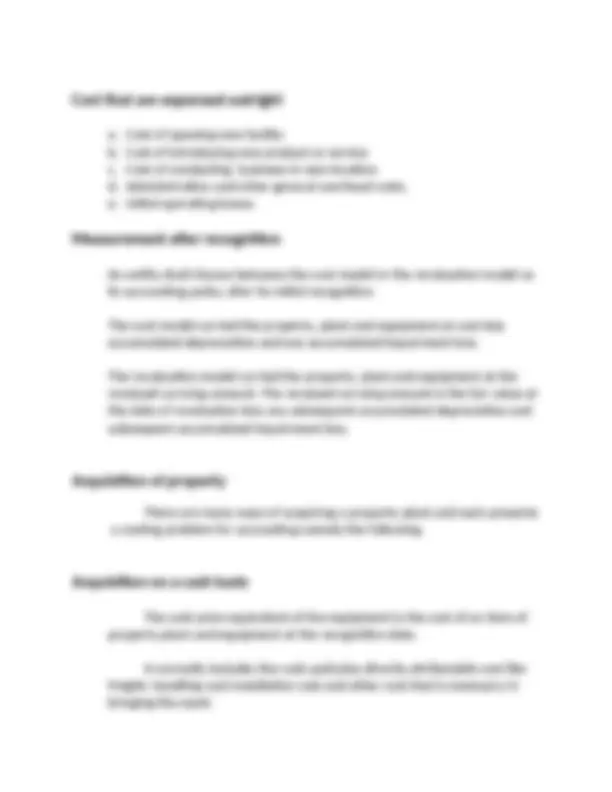
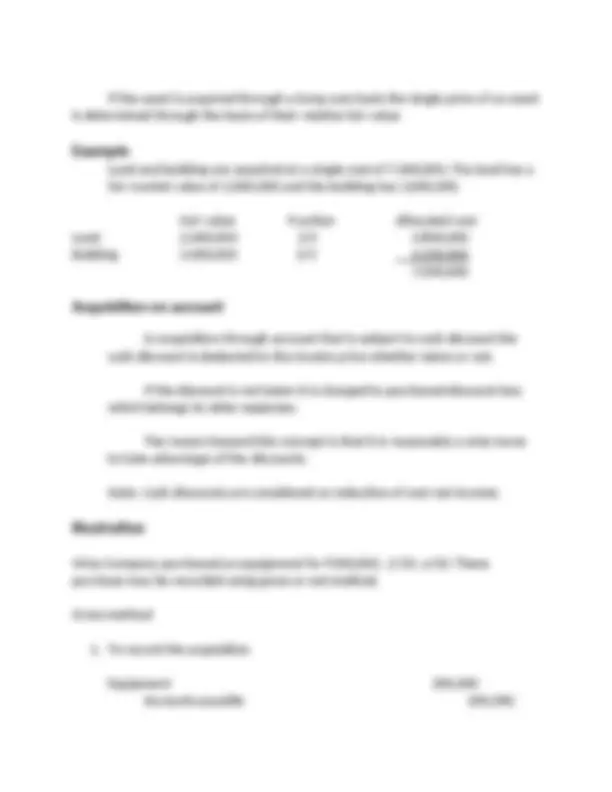
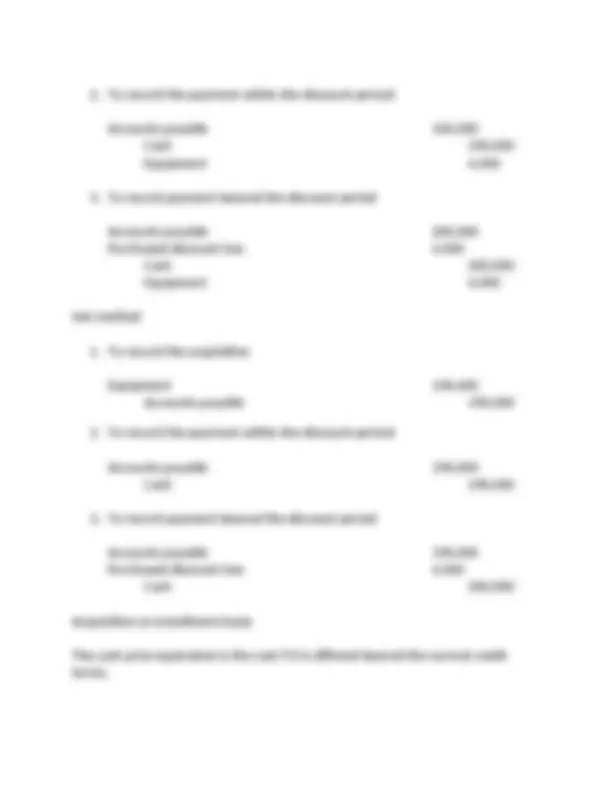
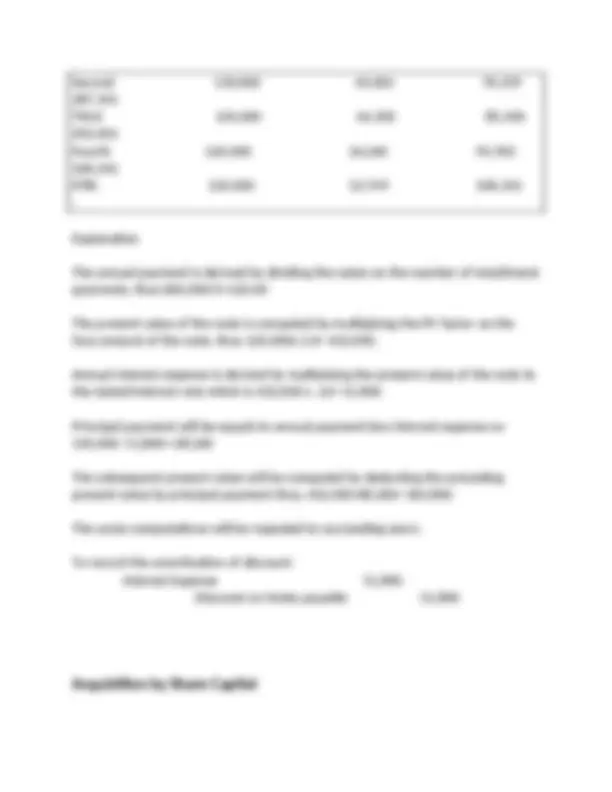
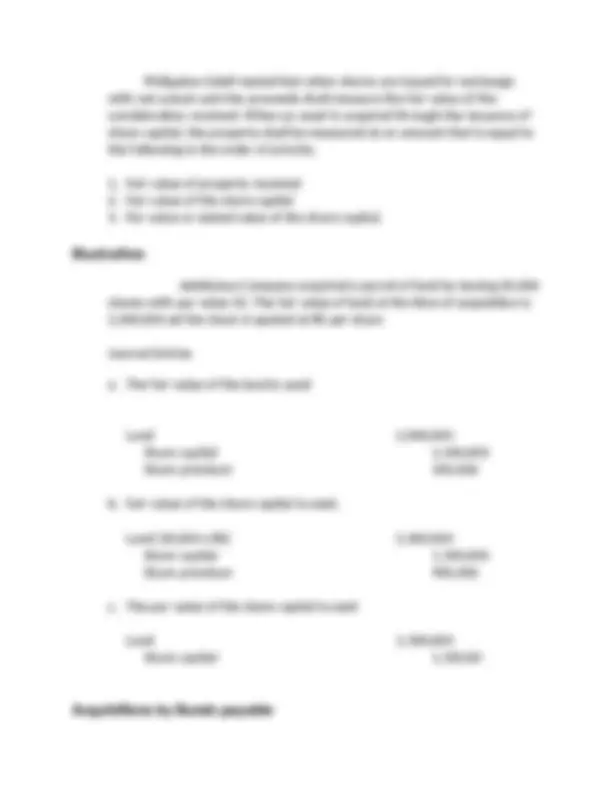
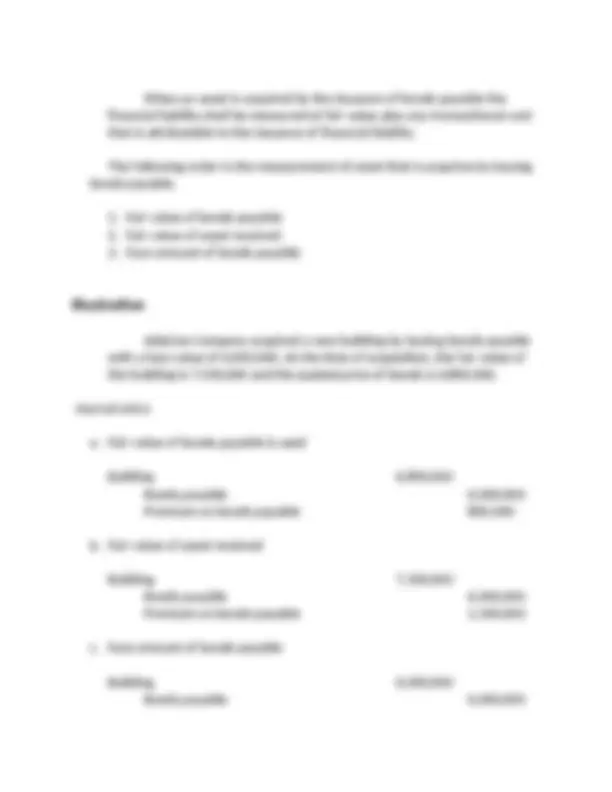
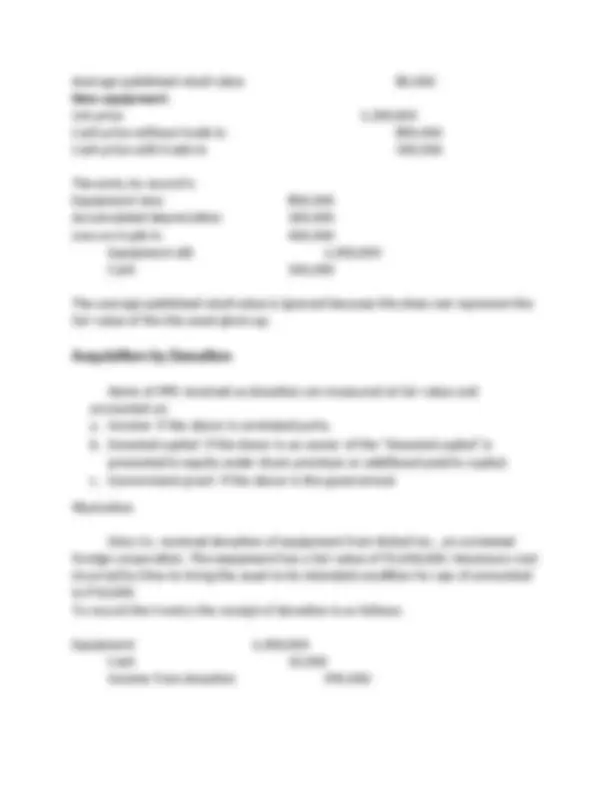
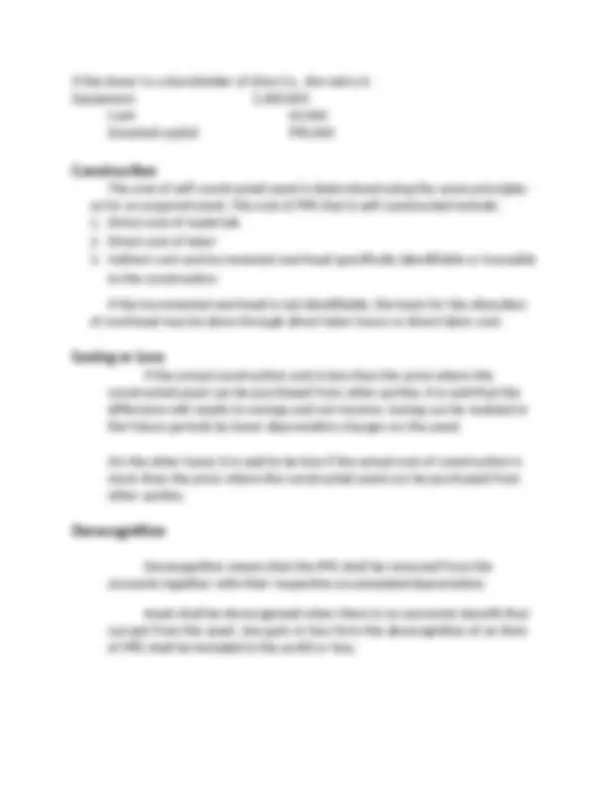
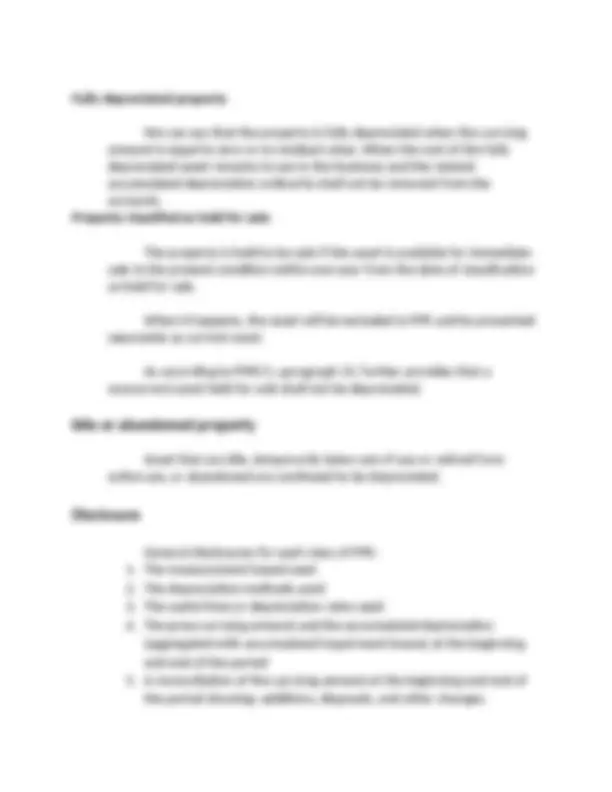
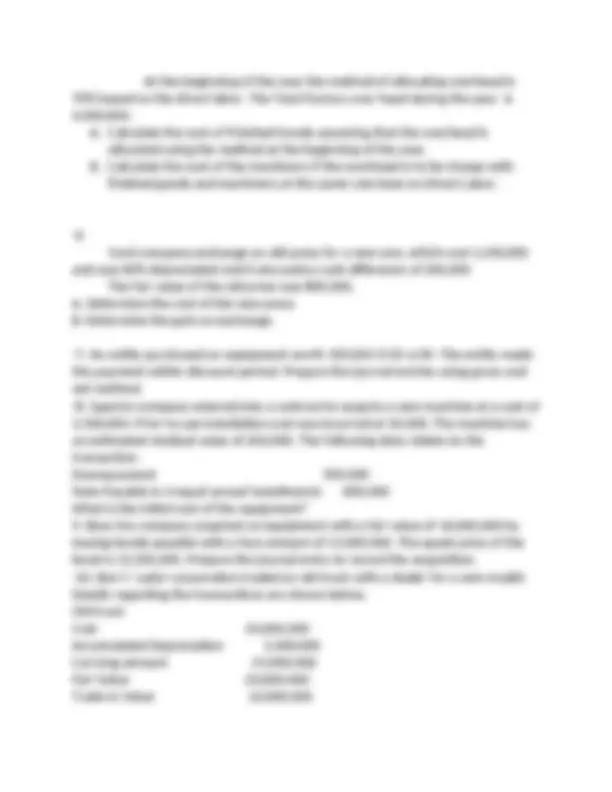

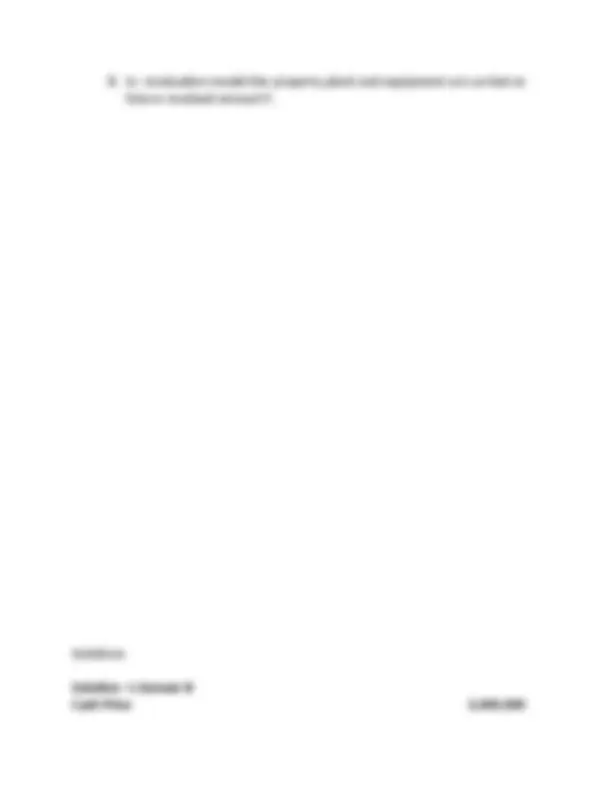
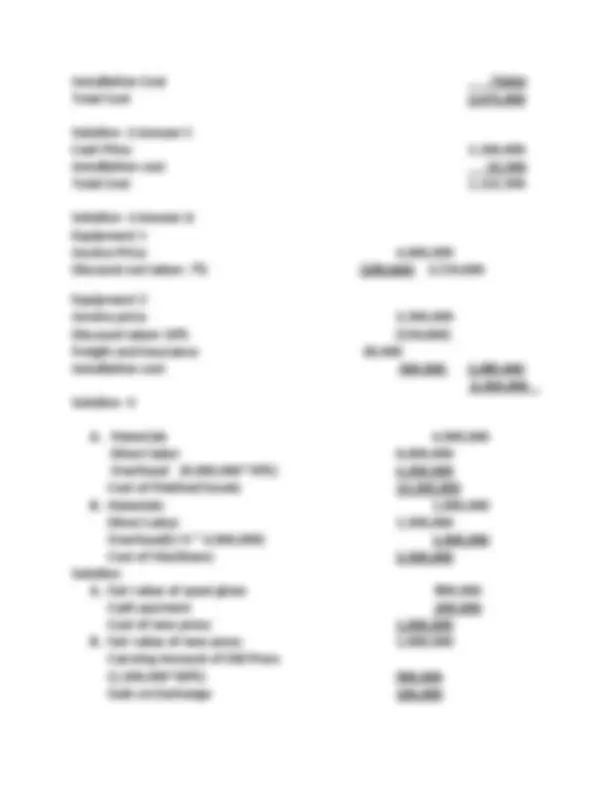
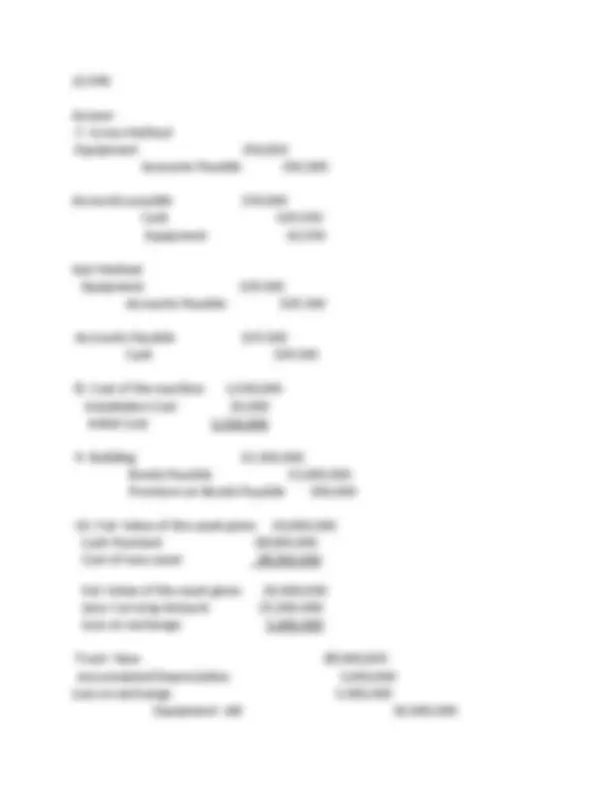
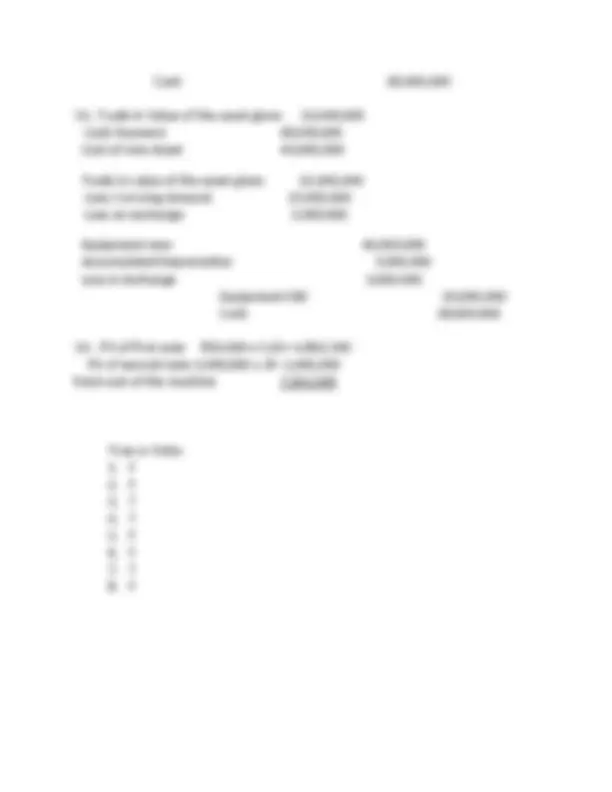


Study with the several resources on Docsity

Earn points by helping other students or get them with a premium plan


Prepare for your exams
Study with the several resources on Docsity

Earn points to download
Earn points by helping other students or get them with a premium plan
Community
Ask the community for help and clear up your study doubts
Discover the best universities in your country according to Docsity users
Free resources
Download our free guides on studying techniques, anxiety management strategies, and thesis advice from Docsity tutors
The definition, recognition, and initial measurement of property, plant, and equipment (PPE). It also discusses the acquisition of PPE through installment, exchange, and trade-in transactions. examples of PPE and the direct cost that can be attributed to it. It also includes journal entries and illustrations to explain the accounting treatment of PPE in different scenarios.
Typology: Lecture notes
1 / 23

This page cannot be seen from the preview
Don't miss anything!
















Property, plant and equipment is the long-term asset or noncurrent asset section of the balance sheet that reports the tangible, long-lived assets that are used in the company's operations. These assets are commonly referred to as the company's fixed assets or plant assets. Property plant and equipment are a. Tangible assets (physical substance) b. Used in business (used in production, services, rental or administrative purposes) c. Long term in nature (more than 1-year useful life) Examples of property, plant and equipment a. Land used in business b. Land held for future plant sites c. Building d. Machinery e. Ship f. Equipment used in production g. Equipment held for environmental and safety reasons h. Equipment held for rentals i. Motor vehicle j. Aircraft
k. Furniture and fixtures l. Bearer plants Recognition of property, plant and equipment An item of property plant and equipment is recognized if: a. Future economic benefits associated with the asset will flow to the entity b. The cost of the item van be measured reliably
Spare parts, stand by equipment and servicing equipment are recognized as PPE if they meet the definition of PPE that it should be use with more than 1 year.
An item of property, plant and equipment is initially measured at cost and it cis comprises by the following. a. Purchase price, including the import duties, non-refundable purchase taxes, and deduction of trade discounts and rebates b. Direct cost of bringing the asset to its intended location c. Cost of dismantling and removing asset and site restoration cost which the entity incurs an obligation.
a. Cost of site preparation b. Cost of employee benefits directly from the construction or acquisition of PPE c. Initial delivery and handling costs d. Installation cost e. Professional fees f. Testing cost.
If the asset is acquired through a lump sum basis the single price of an asset is determined through the basis of their relative fair value
Land and building are acquired at a single cost of 7,000,000. The land has a fair market value of 2,000,000 and the building has 3,000,000. Fair value Fraction Allocated cost Land 2,000,000 2/5 2,800, Building 3,000,000 3/5 4,200, 7,000,
In acquisition through account that is subject to cash discount the cash discount is deducted to the invoice price whether taken or not. If the discount is not taken it is charged to purchased discount loss which belongs to other expenses. The reason beyond this concept is that it is reasonably a wise move to take advantage of the discounts. Note. Cash discounts are considered as reduction of cost not income.
Vinia Company purchased an equipment for P200,000 , 2/10, n/30. These purchase may be recorded using gross or net method. Gross method
In some situations, an asset may be acquired by installment. However, there is no cash price. In that case, the present value factor of all installment payments will be used to calculate the price of the of the asset.
Boss OCs company acquired a robot at an installment price of 900,000. The terms are 300,000 down payment and the balance is payable in 5 equal installments. A note is issued for the remaining balance and there is no available cash price for the machinery. The implied interest for this type of note is 12%. Using the implied interest rate, the present value of an ordinary annuity of 1 is 3.60. Down payment 300, PV of note payable 600,000/5=120,000 x 3.6 432, Cost of the robot 732, Notes Payable 600, PV of Notes 432, Implied Interest (Discount) 168, To Journalize the acquisition of the robot Robot 732, Discount on Notes Payable 168, Cash 300, Notes Payable 600, To record the installment payment Notes Payable 120, Cash 120, To Illustrate the amortization of discount, we create an amortization table using the effective interest method. Year Payment Interest Principal Carrying Amount Acquisition 432, First Installment 120,000 51,840 68, 363,
Second 120,000 43,661 76, 287, Third 120,000 34,500 85, 202, Fourth 120,000 24,240 95, 106, Fifth 120,000 12,749 106,
Explanation The annual payment is derived by dividing the notes on the number of installment payments, thus 600,000/5=120, The present value of the note is computed by multiplying the PV factor on the face amount of the note, thus 120,000x 3.6= 432,000. Annual interest expense is derived by multiplying the present value of the note to the stated interest rate which is 432,000 x .12= 51, Principal payment will be equals to annual payment less interest expense so 120,000- 51,840= 68, The subsequent present value will be computed by deducting the preceding present value by principal payment thus, 432,000-68,260= 363, The same computations will be repeated to succeeding years. To record the amortization of discount Interest Expense 51, Discount on Notes payable 51,
When an asset is acquired by the issuance of bonds payable the financial liability shall be measured at fair value plus any transactional cost that is attributable to the issuance of financial liability. The following order is the measurement of asset that is acquires by issuing bonds payable.
AdeLine Company acquired a new building by issuing bonds payable with a face value of 6,000,000. At the time of acquisition, the fair value of the building is 7,500,000 and the quoted price of bonds is 6,800,000. Journal entry a. Fair value of bonds payable is used Building 6,800, Bonds payable 6,000, Premium on bonds payable 800, b. Fair value of asset received Building 7,500, Bonds payable 6,000, Premium on bonds payable 1,500, c. Face amount of bonds payable Building 6,000, Bonds payable 6,000,
PPE can be acquired in exchange of either nonmonetary assets or assets or a combination of nonmonetary assets. The measurement of the PPE can be acquired depends on whether the transaction has a commercial substance or not. (Millan, 2019) It can be said that it has a commercial substance when the entity’s subsequent cash flows are expected to change as a result of the exchange. The PPE received can be measure using the following order of priority: a. FV of the asset given up (plus cash paid or minus cash received) b. FV of the asset received c. Carrying amount of the asset given up (plus cash paid or minus cash received) Meanwhile, it can be said that it lacks commercial substance when the PPE received at the carrying amount of the asset given up (plus cash paid or minus cash received). Note, there is no gain or loss arises if the asset received is measured at the carrying amount of the asset given up. Illustration: B and C exchange equipment B C Equipment 1,500,000 1,800, Accumulated depreciation 800,000 1,000, Carrying amount 700,000 1,050, Fair value 500,000 800, Cash paid by B to C 300,000 300, With commercial substance Book of B Equipment-new 800, Accumulated depreciation 800,
Average published retail value 80, New equipment: List price 1,200, Cash price without trade in 800, Cash price with trade in 500, The entry to record is Equipment-new 800, Accumulated depreciation 300, Loss on trade in 400, Equipment-old 1,000, Cash 500, The average published retail value is ignored because this does not represent the fair value of the the asset given up.
Items of PPE received as donation are measured at fair value and accounted as: a. Income- if the donor is unrelated party. b. Donated capital- if the donor is an owner of the “donated capital’ is presented in equity under share premium or additional paid-in capital. c. Government grant- if the donor is the government Illustration Dino Co. received donation of equipment from Rafael Inc., an unrelated foreign corporation. The equipment has a fair value of P1,000,000. Necessary cost incurred by Dino to bring the asset to its intended condition for use of amounted to P10,000. To record the t=entry the receipt of donation is as follows: Equipment 1,000, Cash 10, Income from donation 990,
If the donor is a shareholder of Dino Co., the netry is Equipment 1,000, Cash 10, Donated capital 990,
The cost of self-constructed asset is determined using the same principles as for an acquired asset. The cost of PPE that is self-constructed include:
If the actual construction cost is less than the price where the constructed asset can be purchased from other parties, it is said that the difference will results to savings and not income. Saving can be realized in the future periods by lower depreciation charges on the asset. On the other hand, it is said to be loss if the actual cost of construction is more than the price where the constructed asset can be purchased from other parties.
Derecognition means that the PPE shall be removed from the accounts together with their respective accumulated depreciation. Asset shall be derecognized when there is no economic benefit that can get from the asset. Any gain or loss form the derecognition of an item of PPE shall be included in the profit or loss.
Problem - Noelle Company acquired a new machine through a contract. The new machine had a cash price of P3,000, Down payment 500, Note Payable in 4 equal installments 1,600, 25,000 ordinary shares with a par value of 30 and fair value of 50 each share 1,250, Additional information. Installation cost of 75,000 was incurred. The machine has an estimated residual value of P150, What is the initial cost of the machine? A. 3,000, B. 3,075, C. 3,400, D. 2,925, Problem- Yuno Company purchased a new machine on a deferred payment basis. A down payment of P200,000 was made and 3 monthly installments of P350, are to be made in end of each month. The cash equivalent price of the machine was P1,100,00. The entity incurred and paid installation costs amounting to P22,500. What is the amount to be capitalized as cost of the machine? A. 1,100, B. 1,200, C. 1,122, D. 1,350, Problem- The following pertains to Gauche Company property acquisition during the year.
-Acquired a land in exchange of 45,000 shares of Gauche Company with P120 par value that had a fair market value of P154 per share on the date of acquisition. -Received land from a major shareholder as a way to locate a warehouse in the city. No payment was required but the entity paid P75,000 for legal expenses for land transfer. The land was bought 3 years ago at P1,100,000 and for the current year have a fair market value of 1,300,000. What is the total increasem in land as a result of the acquisitions? A. 8,230, B. 6,930, C. 6,700, D. 8,030, Problem - Luck Company have the following transactions regarding the acquisitions of two equipment.
Fuegoleon company has the following information regarding to their manufacturing and construction activities for 2019 Machinery Finished Goods Materials 1,000,000 4,000, Direct Labor 1,500,000 6,000,
New Truck List Price 40,000, Trade in value of old truck 22,000, Cash Payment 18,000, Prepare the journal entry using the fair value approach -11. In the preceding problem, prepare the journal entry using trade in value approach -12. Red Horse company acquired two equipment for making beers. On December 31, 2019 the company purchased and equipment worth 750,000 for a noninterest bearing note requiring ten annual payments for 850,000, the first payment was made on December 31,2020 and the others are due annually every December 31. The prevailing interest rate on this note was 12%. The present value of an ordinary annuity of 1 at 12% is 5.65 for 10 periods. On the same date an entity acquired another machine by issuing the seller a two-year noninterest bearing note for 3,000,000. The present value of 1 at 12% for two years is .80 and the present value of ordinary annuity of 1 at 12% for 2 years is 1.69. Compute for the total cost of the machinery True or False